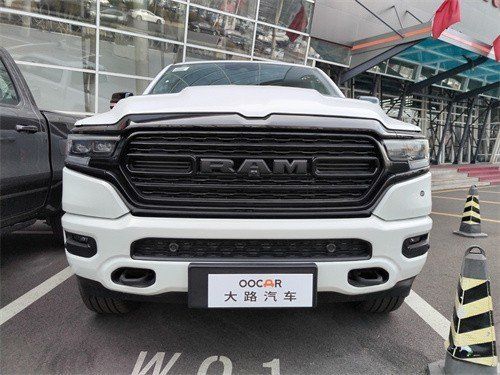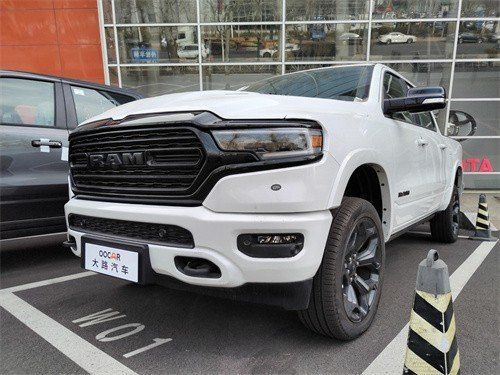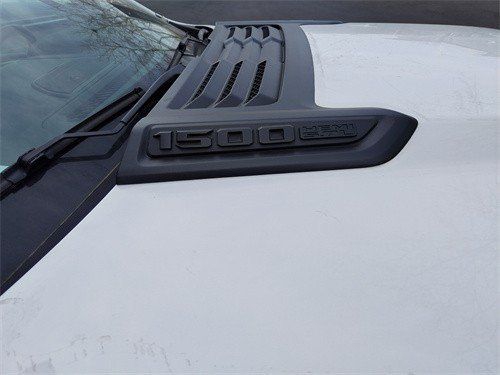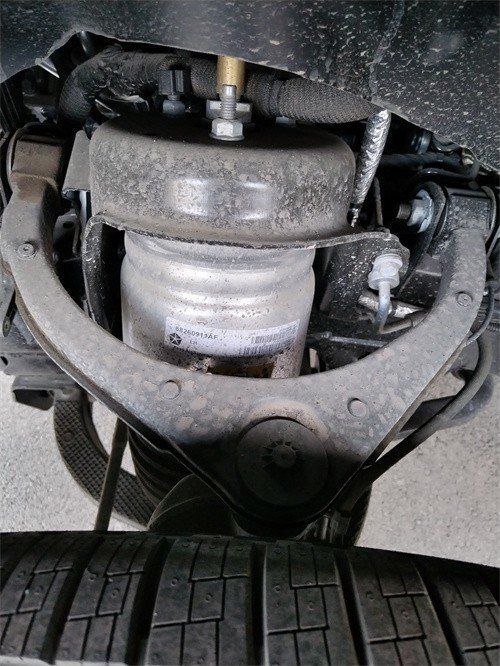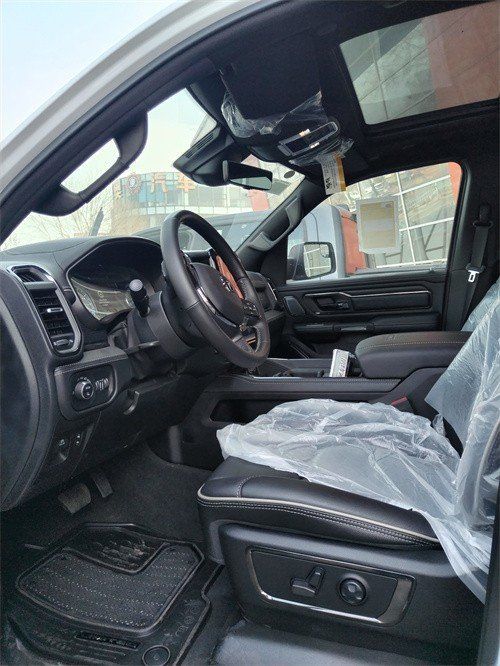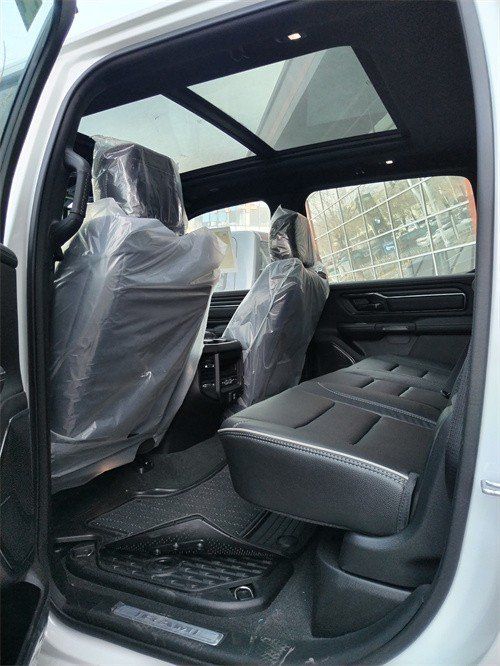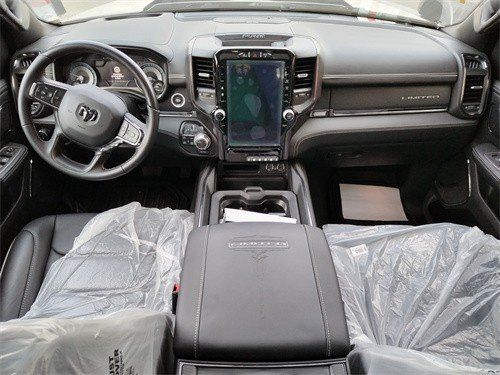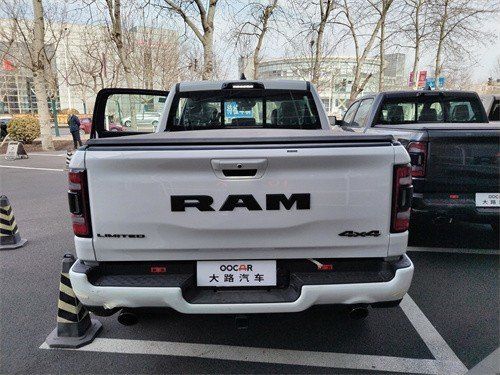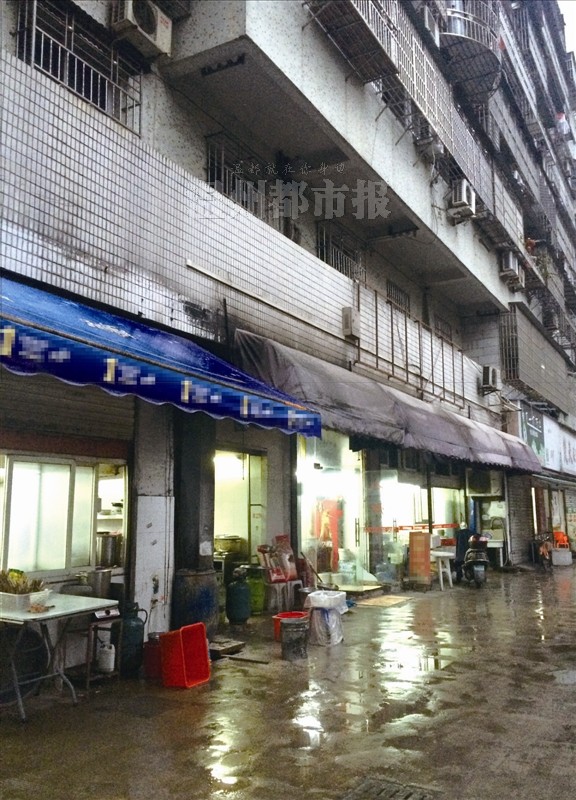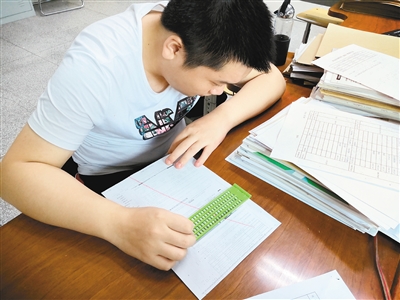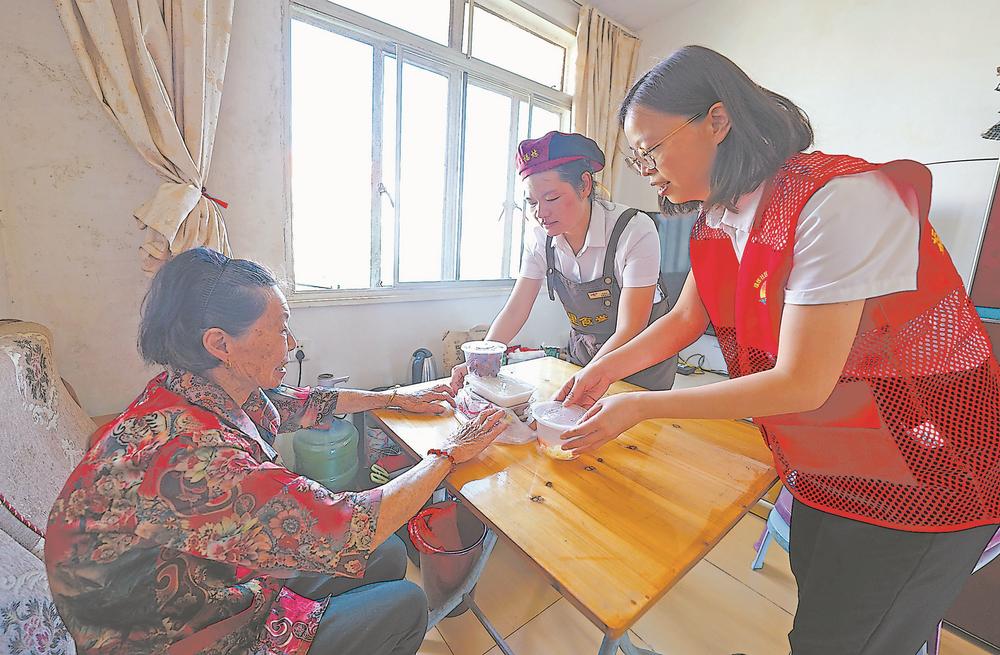China Haiphong: Zhang Zhou resigned as the chief financial officer of the company.
On March 7th, () announced that recently, the board of directors of the company received the written resignation of Mr. Zhang Zhou, the company’s deputy general manager and chief financial officer. Mr. Zhang Zhou applied to resign as the company’s deputy general manager and chief financial officer because he has reached the legal retirement age, and he will no longer hold any position in the company after his resignation. According to relevant laws and regulations and the Articles of Association, Mr. Zhang Zhou’s resignation report will take effect as of the date it is delivered to the board of directors.
(): Sun Company received the Approval Document of Veterinary Drug Products.
On March 7th, Sinopharm Hyundai announced that recently, the company Sun Company Qinghai Bio-pharmaceutical Factory Co., Ltd. received the Approval Document of Veterinary Drug Products issued by the Ministry of Agriculture and Rural Affairs of the People’s Republic of China, and approved the registration of inactivated sheep septicemia streptococcus vaccine (100ml/ bottle, 250ml/ bottle).
Pingmei shares: not redeeming "Pingmei convertible bonds" in advance.
On March 7th, () announced that the closing price of the company’s shares for 15 trading days from February 7th, 2024 to March 6th, 2024 was not less than 130% of the current conversion price of "Pingmei Convertible Bonds" (that is, 11.778 yuan/share), which triggered the conditional redemption clause of "Pingmei Convertible Bonds". The board of directors of the company decided not to exercise the right of early redemption of "flat coal convertible bonds" and not to redeem "flat coal convertible bonds" in advance.
The settlement between CDB and Lotus Health will completely solve this historical problem.
On the evening of March 6th, () announced that the company had signed the Implementation Reconciliation Agreement with Henan Branch of China Development Bank. According to the agreement, under the execution case of Zhoukou Intermediate People’s Court (2023) Yu 16 Zhihui No.90, Lotus Health should pay off 36,844,900 yuan to Henan Branch of China Development Bank, and repay it in five installments. The announcement shows that since 2024, 3 million yuan, 3 million yuan, 3.5 million yuan and 3.5 million yuan will be repaid in the first four years, and will be paid off in 2028. This has no operational pressure on the health of the lotus that has been developing continuously, and will completely solve the problems left over from history many years ago.
According to public information, since the successful reorganization of Lotus Health in 2020, its business development has continued to improve and its profitability has continued to increase. Lotus Health’s previously released 2023 performance forecast shows that the net profit in 2023 is expected to reach 120 million yuan to 150 million yuan, a year-on-year increase of 159.92% to 224.91%. According to publicly disclosed data, this is not only the best profit year since the healthy reorganization of Lotus, but also the best year in more than 20 years. It can be seen that after several years of recovery and development, the healthy management of lotus has undergone fundamental improvement.
The signing amount of the first shares in January and February was 4.299 billion yuan, a year-on-year decrease of 47.25%.
() Announced that in January and February of 2024, the company achieved a total contracted area of 216,500 square meters, a year-on-year decrease of 44.60%; The contracted amount was 4.299 billion yuan, a year-on-year decrease of 47.25%. Among them: 1) The company and its holding subsidiaries have achieved a total contracted area of 115,500 square meters (including underground garages, etc.) with a contracted amount of 2.429 billion yuan. 2) The company’s cooperation projects have achieved a total contracted area of 101,000 square meters (including underground garages, etc.), with a contracted amount of 1.87 billion yuan.
Initial shares: the contracted amount in January and February decreased by 47.25% year-on-year.
The first announcement of shares, in January and February, the company achieved a total contracted area of 216,500 square meters, a year-on-year decrease of 44.60%; The contracted amount was 4.299 billion yuan, a year-on-year decrease of 47.25%.
Initial shares: the contracted amount in January and February was 4.299 billion yuan.
On March 7th, the shares were announced for the first time. From January to February, the company achieved a total contracted area of 216,500 square meters, a year-on-year decrease of 44.60%. The contracted amount was 4.299 billion yuan, a year-on-year decrease of 47.25%.
Shennong Group: In February, the company’s pig sales revenue was 210 million yuan.
() Announcement: In February 2024, the company sold 130,900 pigs (including 128,500 commercial pigs), with a sales income of 210 million yuan. Among them, 17,700 pigs were sold to slaughter enterprises within the group. In February 2024, the price of the company’s commercial pigs showed a downward trend, and the average selling price of commercial pigs was 13.04 yuan/kg, which was 0.69% lower than that in January 2024.
First shares: In January and February, the company achieved a total contracted area of 216,500 square meters, a year-on-year decrease of 44.60%.
The first share announcement, in January and February 2024, the company achieved a total contracted area of 216,500 square meters, a year-on-year decrease of 44.60%; The contracted amount was 4.299 billion yuan, a year-on-year decrease of 47.25%.
Jifeng Co., Ltd. obtained a total estimated life cycle of 7.8 billion yuan for the passenger car seat assembly project.
() Announced that the company has recently received the Letter of Intent for Fixed-point Supplier from customers. The company has obtained the fixed-point seat assembly project of a new energy automobile main engine factory (limited to confidentiality agreement, whose name cannot be disclosed) and will develop and produce seat assembly products for customers. According to the customer’s plan, the project is expected to start in October 2024, with a life cycle of 5 years, with an estimated total life cycle of 7.8 billion yuan.
This new designated project is that the original customer will designate its new model to the company again. Once again, the company won the project designation of the original customer, which reflected the customer’s recognition of the company’s ability and services provided in the process of cooperation. At the same time, the continuous accumulation of orders in hand also created conditions for the company’s future production to form economies of scale. This project is not expected to have a significant impact on the company’s performance this year, but the project designation will help improve the company’s business income this year and in the future, and have a positive impact on the company’s future business performance.
Jifeng Co., Ltd.: Obtained the fixed point of passenger car seat assembly project
Jifeng Co., Ltd. announced that the company recently received the Letter of Intent for Fixed-point Supplier, and the company obtained the fixed-point seat assembly project of a new energy automobile main engine factory, and will develop and produce seat assembly products for customers. According to the customer’s plan, the project is expected to start from October 2024, with a life cycle of 5 years, with an estimated total life cycle of 7.8 billion yuan. It will not have a significant impact on the company’s performance this year.
Xing Yin currency and Xing Yin cash to increase fund manager Huang Zhaoren.
Today, Xingyin Fund Management Co., Ltd. announced that Xingyin Currency and Xingyin Cash added funds manager Huang Zhaoren.
Huang Zhaoren has served as a data analyst of American GoHealth Insurance Company, a fund business accountant of the Operation Management Department of the Head Office of Industrial Bank Co., Ltd., and a trader of the Fund Management Department of the Planning and Finance Department of the Head Office. In August 2023, he joined Xingyin Fund Management Co., Ltd. and is currently the fund manager of the fixed income department.
Xing Yin Currency A and B were established on August 27th, 2014. By March 6th, 2024, their yields were 25.25% and 27.57% respectively.
Xingyin Cash Tianli A was established on December 30, 2016, and Xingyin Cash Tianli C was established on March 9, 2023. As of March 6, 2024, its yields were 18.99% and 2.39% respectively.


Jifeng shares: obtained the designated seat assembly project of a new energy automobile main engine factory.
Jifeng shares announced in the evening that the company has obtained the designated seat assembly project of a new energy automobile main engine factory and will develop and produce seat assembly products for customers. According to the customer’s plan, the project is expected to start from October 2024, with a life cycle of 5 years, with an estimated total life cycle of 7.8 billion yuan.
Jifeng shares: designated by the passenger car seat assembly project.
Jifeng Co., Ltd. announced that the company recently received the "Letter of Intent for Fixed-point Supplier" from customers, and the company won the fixed-point seat assembly project of a new energy automobile main engine factory, and will develop and produce seat assembly products for customers. According to the customer’s plan, the project is expected to start from October 2024, with a life cycle of 5 years, with an estimated total life cycle of 7.8 billion yuan.
() International Holding Group Co., Ltd.: 21 Yingda 01 will pay the principal and interest in the first phase on March 18, 2024 and be delisted.
On March 7, State Grid Yingda International Holding Group Co., Ltd. announced the redemption and delisting of principal and interest, and 21 Yingda 01 (bond code: 175860.SH) will be delisted on March 18, 2024.
State Grid Yingda International Holding Group Co., Ltd. will publicly issue corporate bonds (Phase I) to professional investors in 2021 (hereinafter referred to as "current bonds"), and will begin to pay the last annual interest and principal of the bonds from March 18, 2023 to March 17, 2024 on March 18, 2024.
According to the announcement, this bond is a 3-year fixed-rate bond, and the interest-bearing period is from March 18, 2021 to March 17, 2024, with coupon rate accounting for 3.59%.
23 Longsheng SCP012 (science and technology bill) will be paid in Japan on March 19, 2024, totaling 506,737,704.92 yuan.
According to the website of the Association of Interbank Market Dealers, () Group Co., Ltd. announced the interest payment arrangement of 23 Longsheng SCP012 (Science and Technology Bill). The principal and interest payment date of this bond (bond abbreviation: 23 Longsheng SCP012 (Kechuang Bill), bond code: 012383533.IB) is March 19, 2024, and the bond interest rate during the interest period is 2.74%, and the repayment category is principal and interest payment, totaling 506,737,704.92 yuan.
China Catalyst: 4,271,200 restricted shares will be listed and circulated on March 18th.
China Catalyst announced the listing and circulation of some restricted shares in the initial public offering. The total number of shares listed and circulated this time was 4,271,200 shares, accounting for 2.42% of the company’s total share capital. The above shares will be listed and circulated on March 18, 2024 (March 16, 2024 is a non-trading day, so it will be postponed to the next trading day).
ArcSoft Technology appoints Wei Kai as Chief Financial Officer.
ArcSoft Technology announced that the company held the 14th meeting of the second board of directors on March 6, 2024, and reviewed and passed the Proposal on Changing the Chief Financial Officer. In response to the adjustment of the company’s organization and talent structure, Mr. Lin Chengchuan was removed from the post of Chief Financial Officer, and Mr. Lin Chengchuan will continue to hold other positions in the company. Nominated by the general manager of the company, approved by the Nomination Committee and the Audit Committee of the board of directors, the board of directors decided to appoint Ms. Wei Kai, the current deputy financial director, as the company’s chief financial officer, with a term of office from the 14th meeting of the second board of directors to the expiration of the term of the second board of directors.
() The Fourth Institute of Machinery, a subsidiary company, received the Decision of Non-prosecution.
SINOMACH announced that the Fourth Design and Research Institute of Mechanical Industry, a wholly-owned subsidiary of China Automotive Industry Engineering Co., Ltd. (hereinafter referred to as the "Fourth Institute of Machinery") received the Notice of Criminal Suspects’ Litigation Rights and Obligations from the People’s Procuratorate of Wuzhong District, Suzhou City, Jiangsu Province on July 6, 2023. The case of the Fourth Institute of Machinery suspected of colluding in bidding has been transferred from the branch directly under the Suzhou Public Security Bureau to the Wuzhong District People’s Procuratorate in Suzhou, Jiangsu Province for prosecution.
After accepting the above-mentioned cases, the People’s Procuratorate of Wuzhong District, Suzhou City, Jiangsu Province interrogated the Fourth Institute of Machinery according to law, listened to the opinions of the Fourth Institute of Machinery and its defenders, and reviewed all the case materials. On March 6, 2024, the company received the Decision of Not Prosecuting issued by the People’s Procuratorate of Wuzhong District, Suzhou City, Jiangsu Province. The procuratorate believed that the Fourth Mechanical Engineering Institute had committed the acts stipulated in Article 223 of the Criminal Law of People’s Republic of China (PRC), but the circumstances of the crime were minor, with the plot of surrendering, pleading guilty and admitting punishment. According to the provisions of Article 37 of the Criminal Law of People’s Republic of China (PRC), there was no need to be sentenced to punishment. According to the second paragraph of Article 177 of the Criminal Procedure Law of People’s Republic of China (PRC), it was decided not to prosecute the Fourth Mechanical Hospital.
SINOMACH: The wholly-owned company received the decision not to prosecute.
On the evening of March 7th, SINOMACH announced that the company had received the Decision of Non-prosecution issued by the People’s Procuratorate of Wuzhong District, Suzhou City, Jiangsu Province on March 6th. The procuratorate believed that the Company’s wholly-owned company, Mechanical Fourth Hospital, had committed the acts stipulated in Article 223 of the Criminal Law of People’s Republic of China (PRC), but the circumstances of the crime were minor, with the circumstances of surrendering, pleading guilty and admitting punishment. According to the provisions of Article 37 of the Criminal Law of People’s Republic of China (PRC), no penalty was required. According to the second paragraph of Article 177 of the Criminal Procedure Law of People’s Republic of China (PRC), it was decided not to prosecute the Fourth Mechanical Hospital. Previously, the case of the Fourth Machinery Institute suspected of colluding in bidding has been transferred from the branch directly under Suzhou Public Security Bureau to the People’s Procuratorate of Wuzhong District, Suzhou City, Jiangsu Province for prosecution.
Meie Technology will hold a general meeting of shareholders on March 26th, and two proposals will be considered.
Meie Technology announced that the first extraordinary shareholders’ meeting will be held on March 26, 2024, and online voting will be held on the same day. Date of record is March 19th, and investors who hold American and Egyptian technology stocks can vote after the market closes on that day.
Venue: Lecture Hall, 3rd floor, Meiai (China) Environmental Technology Co., Ltd., No.101 Lanxia Road, Moling Street, Jiangning District, Nanjing.
A total of two proposals were audited at this general meeting of shareholders, as follows:
1. Proposal on amending the Articles of Association and amending and formulating some governance systems.
2. Proposal on Election of Supervisors.
Sinopharm Modern: Cefoperazone Sodium and Sulbactam Sodium for Injection passed the consistency evaluation of generic drugs.
Sinopharm Hyundai announced on the evening of March 7th that recently, the company’s holding subsidiary Sinopharm Group Zhijun (Shenzhen) Pharmaceutical Co., Ltd. received the Notice of Approval for Drug Supplement Application approved by National Medical Products Administration, and approved cefoperazone sodium and sulbactam sodium for injection to pass the consistency evaluation of generic drug quality and efficacy. Cefoperazone sodium and sulbactam sodium are compound preparations, belonging to the third generation cephalosporins.
The controlling shareholder of Guoxin Energy promised not to reduce its shares within 12 months.
Guoxin Energy announced that the company recently received the Notice Letter on Voluntary Commitment not to reduce the shares of Shanxi Guoxin Energy Co., Ltd. issued by Huaxin Gas Group Co., Ltd. (hereinafter referred to as "Huaxin Gas Group").
In 2021, Huaxin Gas Group, the controlling shareholder of the company, subscribed for 293,330,434 A shares of the company’s non-public offering, which will be listed and circulated on March 11, 2024. Based on its confidence in the company’s future development and recognition of the company’s intrinsic value, Huaxin Gas Group, at the same time, in order to enhance the confidence of investors and effectively safeguard the rights and interests of investors and the stability of the capital market, the controlling shareholder of the company voluntarily promised that within 12 months from the date of listing of the non-public offering shares (that is, from 2024) During the above commitment period, if the newly added shares are converted from capital reserve to share capital, distributed stock dividends, rights issue, etc., they will also abide by the above commitment not to reduce their holdings.
Guoxin Energy: The controlling shareholder voluntarily promises not to reduce the shares of the company within 12 months.
Guoxin Energy announced on the evening of March 7 that 293 million A shares of the company’s non-public offering subscribed by Huaxin Gas Group, the controlling shareholder of the company, will be listed and circulated on March 11, and Huaxin Gas Group voluntarily promises not to reduce its holdings in any way within 12 months from the listing date of the non-public offering (that is, from March 11, 2024 to March 10, 2025).
Sinopharm Modern: Cefoperazone Sodium and Sulbactam Sodium for Injection passed the consistency evaluation.
Sinopharm Modern announced that Sinopharm Group Zhijun (Shenzhen) Pharmaceutical Co., Ltd. (hereinafter referred to as Sinopharm Zhijun), a holding subsidiary of the company, received the Notice of Approval for Supplementary Drug Application issued by National Medical Products Administration, and approved cefoperazone sodium and sulbactam sodium for injection to pass the consistency evaluation of generic drug quality and efficacy.
The announcement shows that cefoperazone sodium and sulbactam sodium are compound preparations and belong to the third generation cephalosporins. This product is suitable for treating the following infections caused by sensitive bacteria: upper and lower respiratory tract infections; Upper and lower urinary tract infections; Peritonitis, cystic duct and other intracavitary infections; Sepsis; Meningitis; Skin and soft tissue infections; Bone and joint infections; Pelvic inflammatory disease, endometrial gonorrhea and other reproductive tract infections.
Minghua Innovation, the shareholder of Ganli Pharmaceutical Co., Ltd., has reduced its shareholding by 1.81%.
() Announcement. Recently, the company received a written notice from the shareholder Minghua Innovation, which reduced its shareholding by 1.81% from February 22, 2024 to March 6, 2024. After the reduction, its shareholding ratio changed from 5.54% to 3.73%.
Guoxin Energy: The controlling shareholder voluntarily promises not to reduce the company’s shares.
Guoxin Energy announced that Huaxin Gas Group Co., Ltd., the controlling shareholder, voluntarily promised not to reduce its shares within 12 months.
Fuyuan medicine repurchases about 1.39% and costs 98.1666 million yuan.
() Announcement: As of March 7, 2024, the company has repurchased 6,687,200 shares, accounting for about 1.39% of the company’s total share capital, an increase of 0.84% compared with the last disclosure. The lowest transaction price is RMB 14.37/share, the highest transaction price is RMB 14.91/share, and the total amount of funds paid is RMB 98,166,600 (excluding transaction costs)
Foreign Service Holdings: It is planned to repurchase and cancel 201,800 restricted shares at 3.21 yuan/share.
() Announcement: On March 7, 2024, the company held the 24th meeting of the 11th Board of Directors and the 17th meeting of the 11th Board of Supervisors, deliberated and passed the Proposal on Repurchase and Cancellation of Some A-share Restricted Shares and Adjustment of Repurchase Price, and agreed to repurchase and cancel some A-share Restricted Shares that have been granted but have not been lifted, and adjust the repurchase price. The number of A-share restricted shares repurchased this time was 201,800, and the repurchase price of A-share restricted shares this time was 3.21 yuan/share.
Tianjin Port: It is proposed to apply for the qualification of delivery warehouse for coke and other goods futures.
() On the evening of March 7th, it was announced that the company decided to apply to Dalian Commodity Exchange for the qualification of designated delivery warehouses for coke, coking coal and iron ore. The project is conducive to further expanding the port service function, promoting the throughput growth of coke and other goods, and enhancing the company’s business income.
Bian Xingcai, the actual controller of Sanfang Lane, died.
() Announcement was made, and the board of directors of the company made a painful announcement. The board of directors of the company received a notice from the family of Mr. Bian Xingcai, the actual controller of the company, who died on March 6, 2024 at the age of 90.
Guoxin Energy: The controlling shareholder promises not to reduce the shares of the company within 12 months.
Guoxin Energy announced that Huaxin Gas Group, the controlling shareholder of the company, subscribed for 293,330,434 A shares of the company’s non-public offering in 2021 and will be listed and circulated on March 11, 2024. Huaxin Gas Group voluntarily promised not to reduce its shares in the company in any way within 12 months from the date of listing of the non-public offering shares (that is, from March 11, 2024 to March 10, 2025). During the above commitment period, if the newly added shares are converted from capital reserve to share capital, distributed stock dividends, rights issue, etc., they will also abide by the above commitment not to reduce their holdings.
Tianjin Pharmaceutical Industry: Fluconazole and Sodium Chloride Injection, a subsidiary drug, passed the consistency evaluation of generic drugs.
() Announcement: Hubei Jinyao Pharmaceutical Co., Ltd., a subsidiary, received the Notice of Approval for Supplementary Application of Fluconazole and Sodium Chloride Injection approved by National Medical Products Administration, and approved this product to pass the consistency evaluation of generic drug quality and efficacy.
Another A-share listed company chairman suddenly resigned! Jinfeng Wine Industry is at the crossroads. Who will pick up Jasson?

() A paper announcement on March 4th announced the departure of Jasson, the chairman and general manager. To the outside world, Jasson’s resignation at this time is somewhat sudden, because his original term of office will end on June 30, 2025.
"Jasson applied for resignation due to job transfer." In response to an interview with China Times, the relevant person in charge of Jinfeng Liquor Industry said that the board of directors held on March 4th decided to appoint Xu Lili as the deputy general manager of the company and act as the general manager. His resignation will not affect the company’s business development.
It is worth mentioning that, in view of Jasson’s resignation, the board of directors of Jinfeng Liquor intends to add Zhu Yong as the company’s director. Zhu Yong is currently the general manager of Sichuan Quanxing Liquor Co., Ltd. For a long time, investors have expected the integration of Quanxing Liquor and Jinfeng Liquor. Regarding the agitation in the market, Jinfeng Wine Industry said that this is a normal personnel transfer and has nothing to do with liquor.
As for the follow-up chairman and general manager who will fill the position, the above-mentioned person in charge of Jinfeng Liquor did not reply to our reporter. But what is certain is that behind this major personnel change, Jinfeng wine industry has a growth bottleneck that needs to be solved urgently.
Jasson left early.
On March 4th, Jinfeng Liquor Industry announced that the board of directors of the company recently received the resignation application from Jasson, the chairman and general manager, and applied to resign as director, chairman and general manager of the 11th board of directors of the company.
It is understood that Mr. Jasson was appointed as the general manager of Jinfeng Liquor Industry in December 2020, was added as the company’s director in January 2021, and was elected as the company’s chairman. According to the information disclosed by Jinfeng Liquor Industry, Mr. Jasson’s original term of office ended on June 30, 2025. Why did he leave early at this time?
"Jasson applied for resignation due to job transfer." The relevant person in charge of Jinfeng Liquor Industry replied to this reporter’s interview, saying that the board of directors held on March 4th decided to appoint Ms. Xu Lili as the deputy general manager of the company and act as the general manager. His resignation will not affect the company’s business development.
Regarding how to evaluate Jasson’s performance during his tenure, the above-mentioned person in charge of Jinfeng Wine Industry told this reporter that Jasson had served as Party Secretary, Chairman and General Manager of Jinfeng Wine Industry. During his tenure, he fully presided over the party Committee, board of directors and operation of the enterprise. He strictly abides by the provisions of the Company Law and Articles of Association, and conscientiously performs his duties according to the tasks and objectives set by the board of directors. He promoted the transformation of the company’s business model, set up two marketing and production centers, improved the integrated management ability, optimized the product structure, actively promoted brand rejuvenation and technological innovation, and made positive contributions to the development of the company.
In view of Jasson’s resignation, the Board of Directors of Jinfeng Liquor Industry plans to add Zhu Yong as the company’s director.
According to the announcement materials, Zhu Yong has successively served as deputy manager of engineering investment department, manager of production management department, director of general manager’s office, assistant to general manager and internal manager of sales city of Shanghai Guanshengyuan Huaguang Brewing Pharmaceutical Co., Ltd., director of sales branch of Shanghai Jinfeng Liquor Co., Ltd., secretary and deputy general manager of Party branch of Quanxing Liquor Sales (Shanghai) Co., Ltd., and executive deputy general manager of Sichuan Quanxing Liquor Co., Ltd. (presiding). He is currently the general manager of Sichuan Quanxing Liquor Co., Ltd..
For a long time, investors have expected the integration of Quanxing Liquor and Jinfeng Liquor. Jinfeng wine industry said that this is a normal personnel transfer and has nothing to do with liquor.
Where will Jinfeng Wine Industry sail?
Although Jinfeng Wine Industry affirmed Jasson’s contribution during his tenure, from the performance point of view, the performance of Jinfeng Wine Industry has not improved significantly since he took office.
Jinfeng Liquor Industry achieved an operating income of 649 million yuan in 2021, a year-on-year increase of 6.83%; The net profit loss of returning to the mother was 12,845,800 yuan, a year-on-year decrease of 204.95%. In 2022, it realized an operating income of 662 million yuan, a year-on-year increase of 1.88%, and a net profit of 5,171,900 yuan, turning losses into profits.
In the first three quarters of 2023, the revenue was 360 million yuan, down 13.45% year-on-year, and the non-net profit was-27.8055 million yuan. Among the three A-share listed companies (), () and Jinfeng Liquor, the revenue of Jinfeng Liquor declined the most during the same period.
As for the reasons for the decline in performance, Jinfeng Liquor told this reporter that since 2023, the competition in Shanghai’s stock market has become increasingly fierce, and the company’s sales are facing challenges. From July to September, the operating income decreased by 25.35 million yuan compared with the same period, resulting in a year-on-year decline in profits.
In fact, not only Jinfeng wine industry, but also the whole yellow rice wine industry has not solved the long-standing development "shackles". At present, the yellow rice wine industry is still in a difficult revival process.
Talking about the main difficulties and bottlenecks faced by industrial development, the above-mentioned person in charge of Jinfeng Liquor Industry also admitted to the reporter. First, the limitations of the sales area, the industry production and sales area is limited to Jiangsu, Zhejiang and Shanghai, and no national layout has been formed. Second, the product structure needs to be optimized. At present, low-end products are the main products. Third, the consumer group is relatively single, and it is still dominated by middle-aged and elderly people.
Regarding the development status of the yellow rice wine market, brand marketing expert Lu Shengzhen told the reporter of China Times that the mainstream market of alcohol consumption is in catering channels, family banquet channels and business channels. However, in the consumption scenes of Jiangsu, Zhejiang and Shanghai, the market visibility of these channels is very low. The mainstream market has not yet formed a strong consumption. In other provinces, the consumption of yellow rice wine is very accidental and the consumption intention is very low. No matter which rice wine brand has not established a real national market structure, nor has it formed a strong consumer culture in the national liquor market.
"It is necessary to actively explore the development from regionalization to nationalization and seek more development opportunities. It is necessary to expand the consumer market of young groups and high-end groups through product upgrading, taste innovation and cultural communication, and broaden more consumption scenarios. " The above-mentioned person in charge of Jinfeng Wine Industry said.
"If rice wine enterprises want to break through, they must take the road of high-end, rejuvenation and nationalization." The relevant person in charge of Huijishan also told the reporter of China Times.
The above-mentioned person in charge of Jinfeng Liquor Industry believes that the traditional regional boundaries of yellow rice wine are gradually broken and the competition is intensified, driven by intensified competition in stocks and incremental expansion demand; Channels and scenes are gradually diversified; The structural upgrading of products has accelerated; Industry concentration is further concentrated.
Jinfeng Liquor Industry will actively explore incremental opportunities such as youthfulness, high-end, online and nationalization of yellow rice wine industry by improving product quality, innovating sub-categories and renewing brand image on the basis of reserve, and at the same time, intensively cultivate it by upgrading marketing system, adjusting and optimizing product structure and increasing marketing investment.
Who will pick up the baton next? Where will the new helm lead Jinfeng Wine Industry? Our reporter will continue to pay attention.
New research materials: the company and its holding subsidiaries have received a total of 33,923,724.73 yuan of government subsidies.
On the evening of March 7th, () announced that the company and its holding subsidiaries had received a total of 33,923,724.73 yuan of government subsidies since the last announcement of government subsidies, including 8,774,100.00 yuan related to assets and 25,149,624.73 yuan related to income.
Tenglong shares: 420,000 shares of the company were repurchased on March 7.
On the evening of March 7, () announced that on March 7, 2024, the company repurchased 420,000 shares of the company through the Shanghai Stock Exchange system by centralized bidding, accounting for 0.09% of the company’s current total share capital.
Guofa shares: Sun Company Goldman Sachs Zhizao was re-recognized by high-tech enterprises.
On the evening of March 7, () announced that Guangzhou Goldman Sachs Zhizao Technology Co., Ltd. (hereinafter referred to as "Goldman Sachs Zhizao"), a 52% subsidiary of Guangzhou Goldman Sachs Biotechnology Co., Ltd., a wholly-owned subsidiary of the company, recently received the Certificate of High-tech Enterprise jointly issued by the Guangdong Provincial Department of Science and Technology, the Guangdong Provincial Department of Finance and the Guangdong Provincial Taxation Bureau of State Taxation Administration of The People’s Republic of China, which was re-recognized after the expiration of the original High-tech Enterprise Certificate.
Jianghuai Automobile sold 29,661 vehicles in February, a year-on-year decrease of 25.34%.
() Announcement: In February 2024, the company sold a total of 29,661 vehicles, down 25.34% year-on-year. Among them, the sales volume of new energy passenger cars was 1,745, up 18.71% year-on-year. 18,402 vehicles were exported, a year-on-year increase of 17.20%.
Tianjin Pharmaceutical Industry: Fluconazole and Sodium Chloride Injection, a subsidiary, passed the consistency evaluation of generic drugs.
Jinyao Pharmaceutical announced on the evening of March 7th that its subsidiary Hubei Jinyao Pharmaceutical Co., Ltd. received the Notice of Approval for Supplementary Application of Fluconazole and Sodium Chloride Injection approved and issued by National Medical Products Administration, and approved the drug to pass the consistency evaluation of generic drug quality and efficacy. Fluconazole and sodium chloride injection is used to treat infections caused by various fungi.
Consistency evaluation of generic drugs passed by Hubei Jinyao Pharmaceutical Subsidiary
Jinyao Pharmaceutical announced that Hubei Jinyao Pharmaceutical Co., Ltd. (hereinafter referred to as "Hubei Jinyao"), a subsidiary of the company, received the Notice of Approval for Supplementary Application of Fluconazole and Sodium Chloride Injection approved and issued by National Medical Products Administration, and approved this product to pass the consistency evaluation of generic drug quality and efficacy. Fluconazole and sodium chloride injection is used to treat infections caused by various fungi.
() At that time, the general manager and the chief financial officer received a regulatory warning, because they failed to fulfill their information disclosure obligations in time and made disclosure errors.
On March 7, 2024, the Shanghai Stock Exchange issued an announcement to give regulatory warnings to Shi Wenming, then general manager of Wuhan Donghu High-tech Group, and Yu Ruihua, then chief financial officer.
The announcement detailed the violations of Wuhan Donghu High-tech Group. First of all, the company provided engineering construction services to related party Hubei Hongsheng Engineering Management in 2022, with a transaction amount of 491 million yuan. However, the company only made supplementary disclosure on July 13, 2023, and the information disclosure was not timely. Secondly, in December, 2020, the company’s subsidiary, Hubei Luqiao Group, made a commitment to make up the difference of no more than 995 million yuan for the project loan of 1.824 billion yuan applied by Hubei Hongsheng. However, after Hubei Hongsheng became a related party of the company, the company failed to re-perform the review procedure for the related guarantee with Hubei Hongsheng in time. Finally, some data in the company’s 2022 annual report are not accurate and there are disclosure errors.
These acts violate the relevant provisions of the Listing Rules of Shanghai Stock Exchange and damage the investors’ right to know. For the company’s violations, the Shanghai Stock Exchange has made a regulatory decision on the company’s timely chairman Yang Tao and then secretary of the board Duan Jing.
In addition, according to the determination of Hubei Supervision Bureau, Shi Wenming, then general manager of the company, and Yu Ruihua, then chief financial officer, were not diligent and responsible for the company’s violations, and their actions violated the relevant provisions of the Stock Listing Rules and the commitments made in the Statements and Undertakings of Directors (Supervisors and Senior Managers). Therefore, the Shanghai Stock Exchange issued a regulatory warning to Shi Wenming and Yu Ruihua.
Shanghai Hugong: The business income of satellite component related business and robot system integration business is relatively small.
On March 7th, () announced that the company’s main business has not changed at present, and Shanghai Huhang Satellite Technology Co., Ltd., a wholly-owned subsidiary of the company, is involved in some business related to satellite components, and its operating income accounts for about 1%-2% of the operating income of listed companies; The company is involved in the robot system integration business, and its operating income accounts for about 1%-2% of the operating income of listed companies. The business income of satellite parts related business and robot system integration business accounts for a relatively small proportion, which has no significant impact on the company’s performance.
Weizhixiang’s real controller has accumulated 407,800 shares.
() Announcement: As of March 7, 2024, Xia Jing, the controlling shareholder and actual controller of the company, increased the holding of 407,800 shares of the company by centralized bidding through the Shanghai Stock Exchange system with his own funds, accounting for 0.30% of the company’s total share capital, and the holding amount was 12,018,200 yuan (excluding transaction costs), which exceeded the lower limit of the planned holding amount range of 12 million yuan. Xia Jing will continue to choose the opportunity to increase the company’s shares in accordance with the increase plan.
3 Lianban Shanghai Hugong: The business income of satellite parts related business and robot system integration business accounts for a relatively small proportion.
Shanghai Hugong issued a risk warning announcement, saying that the company’s main business has not changed at present. Shanghai Huhang Satellite Technology Co., Ltd., a wholly-owned subsidiary of the company, is involved in some business related to satellite components, and its operating income accounts for about 1%-2% of the operating income of listed companies; The company is involved in the robot system integration business, and its operating income accounts for about 1%-2% of the operating income of listed companies. The business income of satellite parts related business and robot system integration business accounts for a relatively small proportion, which has no significant impact on the company’s performance. The development of related businesses is related to many factors such as the national development plan for related industries, and there are still uncertainties.
Jilin Aodong issued 2 billion yuan medium-term notes and was accepted for registration.
() Announced that the company recently received the Notice of Acceptance of Registration (Zhongshi Xiezhu [2024]No. MTN208) issued by China Interbank Market Dealers Association, and the dealers association decided to accept the registration of the company’s medium-term notes. The registered amount of the company’s medium-term notes is 2 billion yuan, and the registration amount is valid for 2 years from the date of the notice, which is jointly underwritten by China Agricultural Bank Co., Ltd. and China Minsheng Bank Co., Ltd.
Guangdong Construction Engineering Co., Ltd.: The subsidiary jointly won the bid for a project with a total price of 4.893 billion yuan.
() Announcement, the consortium composed of Guangdong Yuantian Engineering Co., Ltd., a wholly-owned subsidiary, and Guangdong Thermal Power Engineering Co., Ltd., China Energy Construction Group (the organizer) won the bid for the EPC general contracting project of 750MW wind power generation project in Xiqing District, Tianjin, with the winning bid of 4.893 billion yuan and the total project duration of 18 months. Among them, the amount of engineering construction tasks undertaken by Yuantian Company is about 1.846 billion yuan.
Guangdong Construction Engineering Co., Ltd.: The subsidiary jointly won the bid for a project with a total price of 4.893 billion yuan.
Guangdong Construction Engineering announced that the consortium composed of Guangdong Yuantian Engineering Co., Ltd., a wholly-owned subsidiary, and Guangdong Thermal Power Engineering Co., Ltd., a China Energy Construction Group (the organizer) won the bid for the EPC general contracting project of Guangzhou to develop the 750MW wind power project in Tianjin Xiqing District, with the winning bid of 4.893 billion yuan and the total project duration of 18 months. Among them, the amount of engineering construction tasks undertaken by Yuantian Company is about 1.846 billion yuan.
ST Noble: Touching the delisting indicators of trading, stocks will be suspended from March 8.
() Announcement, as of March 7, 2024, the closing price of the company’s stock was 0.67 yuan/share, which has been lower than that of 1 yuan for 20 consecutive trading days and has touched the delisting index of trading; The company’s shares have been suspended since the opening of the market on Friday, March 8, 2024. The Shanghai Stock Exchange will issue a prior notice to the company to terminate its listing within 5 trading days after the company touches the delisting of trading.
Sifang New Materials: The controlling shareholder plans to increase its shareholding by RMB 17 million to RMB 20 million.
() On the evening of March 7th, it was announced that Tak-Chi Lee and Zhang Lilan, the controlling shareholders and actual controllers, planned to use their own funds to increase their shares by 17 million yuan to 20 million yuan through centralized bidding, and the increase price was not higher than 12.78 yuan/share.
The controlling shareholder of Chengyi Pharmaceutical Co., Ltd. increased its holdings by 1%.
() Announcement: From February 6 to March 7, 2024, Yan Xiaoling, the concerted action person of the company’s controlling shareholder, and Wenzhou Dongtou Chengxin Microfinance Co., Ltd. increased their holdings by a total of 3,424,700 shares, accounting for 1.05% of the company’s total share capital.
Jianghuai Automobile: Car sales in the first two months increased by 5.1% year-on-year.
Jianghuai Automobile announced that the sales volume in February 2024 totaled 29,661 vehicles, down 25.34% year-on-year; In the first two months of 2024, the sales volume totaled 68,908 vehicles, a year-on-year increase of 5.10%.
Sanfangxiang: The actual controller, Mr. Bian Xingcai, passed away.
Sanfangxiang announced that the board of directors of the company received a notice from the family of Mr. Bian Xingcai, the actual controller of the company, who died on March 6, 2024 at the age of 90.
ST Noble: The company’s stock touches the trading delisting index and will be suspended from March 8.
ST Noble announced on the evening of March 7th that as of March 7th, the daily stock closing price of the company’s shares for 20 consecutive trading days was lower than that of RMB 1 yuan, which touched the trading delisting index stipulated in the first paragraph of Article 9.2.1 of the Stock Listing Rules. According to the provisions of Article 9.2.6 of the Stock Listing Rules, the company’s shares were suspended from trading on Friday, March 8th. The Shanghai Stock Exchange will issue a prior notice to the company to terminate its stock listing within 5 trading days after the company touches the delisting of trading.
Tianjin pharmaceutical industry: fluconazole and sodium chloride injection passed the consistency evaluation of generic drugs
Jinyao Pharmaceutical announced that Hubei Jinyao, a subsidiary of the company, received the Notice of Approval for Supplementary Application of Fluconazole and Sodium Chloride Injection approved and issued by National Medical Products Administration, and approved this product to pass the consistency evaluation of generic drug quality and efficacy. Fluconazole and sodium chloride injection is used to treat infections caused by various fungi.
Liaoning Chengda: Xinjiang Baoming, a subsidiary, received a decision to cancel the case.
() Announcement: On May 30, 2023, Xinjiang Baoming Mining Co., Ltd., a holding subsidiary of the company, was placed on file for investigation by Jimsar County Public Security Bureau of Xinjiang for allegedly illegally occupying agricultural land. Recently, Baoming, Xinjiang received the Decision of Revoking the Case from Jimsar County Public Security Bureau, and Jimsar County Public Security Bureau decided to dismiss the case.
Yulong completed the repurchase of 5,098,800 shares at a cost of 50,119,300 yuan.
() Announcement: On March 6, 2024, the company completed the repurchase, and actually repurchased 5,098,800 shares of the company, accounting for 0.65% of the company’s total share capital. The highest repurchase price was 11.41 yuan/share, the lowest repurchase price was 8.24 yuan/share, and the total amount of funds used was 50,119,300 yuan (excluding transaction expenses such as stamp duty and transaction commission).
Sifang new materials: the actual controller plans to spend 17 million to 20 million yuan to increase the company’s shares.
Sifang New Materials announced that Tak-Chi Lee and Zhang Lilan, the controlling shareholders and actual controllers of the company, intend to increase their holdings of the company’s shares, with a total increase of not less than 17 million yuan, not more than 20 million yuan, and an increase of not more than 12.78 yuan/share. The implementation period of this shareholding plan is from March 13, 2024 to May 23, 2024, in which March 28, 2024 to April 26, 2024 is the time when it is forbidden to buy or sell the company’s shares.
Mubang Hi-Tech: Bangling International intends to transfer no more than 5.3% of the company’s shares through agreement transfer.
() Announcement, Bangling International intends to transfer no more than 5.3% of the company’s shares through agreement transfer.
Zhuoyi Information completed the repurchase of 526,900 shares at a cost of 19,796,500 yuan.
Zhuoyi Information announced that on March 7, 2024, the company completed this repurchase, and has actually repurchased 526,900 shares of the company through the Shanghai Stock Exchange in a centralized bidding transaction, accounting for 0.61% of the company’s total share capital of 86,956,591 shares. The highest repurchase price is 41.427 yuan/share, the lowest repurchase price is 29.658 yuan/share, and the average repurchase price is about 375,600.
Aonong Bio: The court ruled to accept the reorganization of the controlling shareholder.
() Announcement, Xiangcheng Court ruled on March 7, 2024 to accept the creditor Fujian Dazhou Construction Group Co., Ltd.’ s application for reorganization of Zhangzhou Aonong Investment Co., Ltd., the controlling shareholder of Fujian Aonong Biotechnology Group Co., Ltd.
ST noble: touching the delisting index of trading, stock suspension
ST Noble announced that as of March 7, 2024, the closing price of the company’s stock was 0.67 yuan/share, which has been lower than that of 1 yuan for 20 consecutive trading days, and has touched the trading delisting index stipulated in the first paragraph of Article 9.2.1 of the Listing Rules of Shanghai Stock Exchange (hereinafter referred to as "the Listing Rules").
According to Article 9.2.6 of the Stock Listing Rules, the company’s shares will be suspended from the market opening on Friday, March 8, 2024, and the Shanghai Stock Exchange (hereinafter referred to as "SSE") will issue a prior notice to the company to terminate its stock listing within five trading days after the company touches the delisting situation of trading. The Shanghai Stock Exchange will make a decision on whether to terminate the listing of the company’s shares within 15 trading days after the company touches on the delisting of transactions, according to the audit opinions of the listing Committee.
Weir shares: GDR convertibility period is about to expire.
() On the evening of March 7th, it was announced that the redemption period of Global Depositary Receipts ("GDR") issued by the company this time was from November 10th, 2023 (Central European Time) to March 8th, 2024 (Central European Time), and the redemption period of GDR issued by the company this time was about to expire. After the expiration of the redemption restriction period, GDR can be converted into A shares of the company, which will lead to a corresponding decrease in the number of A shares held by Citibank,National Association as nominal holders of the company’s GDR and enter the domestic market for circulation and trading according to the GDR cancellation instruction. The number of GDR at the expiration of the redemption restriction period is 31 million, corresponding to 31 million A shares of the company, accounting for about 2.55% of the company’s current total share capital.
Sanlian board Dalian Shengya: At present, the company’s production and operation activities have not changed significantly.
() On the evening of March 7th, the stock trading risk warning announcement was disclosed. The company’s main business is the operation of the polar aquarium scenic spot, the commercial operation in the scenic spot and the animal operation. At present, the company’s production and operation activities have not changed significantly. As of March 7, the company’s stock has been trading daily for three consecutive trading days.
Bangling International, the shareholder of Mubang Hi-Tech, intends to transfer no more than 5.3% of the company’s shares by agreement.
Mubang Hi-Tech announced that Bangling International, a shareholder holding 17.96% of the shares, intends to transfer no more than 23 million shares of the company through agreement transfer, that is, the transfer ratio does not exceed 5.3% of the company’s total share capital, and the share transfer period is within 6 months from March 13, 2024. This share transfer is an agreement transfer and does not involve the reduction of the secondary market.
For the sake of the long-term sustainable development of the company and safeguarding the interests of all shareholders, Bangling International has made the following commitments: in the process of collecting the transferee of some shares transferred by agreement, it will explicitly require the transferee to promise to strictly abide by the lock-up period arrangement of relevant laws, regulations, departmental rules and normative documents, and require the transferee to make an additional commitment not to reduce the shares of the company transferred by this agreement within 12 months after the completion of the transfer registration of shares transferred by agreement.
Mubang Hi-Tech: Bangling International intends to transfer no more than 5.3% of the shares of the company by agreement.
Mubang Hi-Tech announced on the evening of March 7 that the shareholder Bangling International intends to transfer no more than 23 million shares of the company through agreement transfer, that is, the transfer ratio does not exceed 5.3% of the company’s total share capital, and the share transfer period is within 6 months from March 13. The above share transfer plan is decided by the shareholders independently according to their own capital needs, and this share transfer will not have a significant impact on the corporate governance structure and going concern.
Haiqi Group: There are still uncertainties in major asset restructuring matters.
() Announcement: The deviation of the daily closing price of the company’s shares in two consecutive trading days on March 6 and March 7, 2024 totaled more than 20%. According to the relevant provisions of the Trading Rules of Shanghai Stock Exchange, it is an abnormal fluctuation of stock trading.
On March 6, 2024, the company disclosed the Report on Hainan Haiqi Transportation Group Co., Ltd. Issuing Shares and Paying Cash to Purchase Assets and Raising Matching Funds and Related Transactions (Draft) and Announcement on the Reorganization and Resumption of Major Assets of the Company (AnnouncementNo.: 2024-027) and other related announcements. As of the disclosure date of this announcement, the company is planning major assets reorganization. It is planned to purchase 100% equity of Hainan Tourism Investment and Development Co., Ltd. (hereinafter referred to as "Hainan Tourism Investment") by issuing shares and paying cash, and raise matching funds (hereinafter referred to as "this transaction"). At present, the transaction still needs to perform the necessary internal decision-making procedures, and it can be formally implemented after being approved by the regulatory authorities, and there are still uncertainties. Investors are advised to invest rationally and pay attention to the trading risks in the secondary market.
Straits Environmental Protection will hold a shareholders’ meeting on March 20th to consider three proposals.
() Announce that the first extraordinary general meeting of shareholders will be held on March 20, 2024, and the online voting date will be March 19. Date of record is on March 13th, and investors who hold shares of Straits Environmental Protection can vote after the market closes on that day.
Meeting place: Company meeting room at No.16 Yangli Road, Gushan Town, Jin ‘an District, Fuzhou, Fujian.
A total of three proposals were audited at this general meeting of shareholders, as follows:
1. Proposal on Downward Revising the Conversion Price of "Haihuan Convertible Bonds"
2. Proposal on Formulation
3. Remuneration Plan for Supervisors of the Fourth Board of Supervisors.
() A shareholders’ meeting will be held on March 25th to consider the proposal of extending the validity period of the resolution of the shareholders’ meeting to issue A-share convertible corporate bonds to unspecified objects.
Xiang Oil Pump announced that the first extraordinary shareholders’ meeting will be held on March 25, 2024, and online voting will be held on the same day. Date of record is March 18th, and investors who hold shares of Hunan Oil Pump can vote after the market closes on that day.
Meeting place: Conference Room 1 of Company, No.69 Hengyue North Road, Chengguan Town, Hengdong County, Hengyang City, Hunan Province.
A total of two proposals were audited at this general meeting of shareholders, as follows:
1. Proposal on Extending the Validity Period of the Resolution of the Shareholders’ General Meeting on the Company’s Issuance of A-share Convertible Corporate Bonds to Unspecified Objects
2. Proposal on requesting the general meeting of shareholders to extend the validity period of authorization for the company to issue A-share convertible corporate bonds to unspecified objects.
() A shareholders’ meeting will be held on March 20th to consider the proposals of wholly-owned subsidiaries applying for syndicated project loans and the company providing guarantees to subsidiaries.
Vogel Optoelectronics announced that the first extraordinary general meeting of shareholders will be held on March 20, 2024, and online voting will be held on the same day. Date of record is March 14th, and investors who hold Vogel Optoelectronic shares can vote after the market closes on that day.
Meeting place: conference room of Vogel Science Park Company, Saiwei Avenue, National High-tech Industrial Development Zone, Xinyu City, Jiangxi Province.
A total of two proposals were audited at this general meeting of shareholders, as follows:
1. Proposal on the wholly-owned subsidiary’s continuing investment in the construction of the chip board loading board project with an annual output of 1 million square meters.
2. Proposal on the application of loan for syndicated projects by wholly-owned subsidiaries and the guarantee provided by the company to subsidiaries.
Avic heavy machinery: the largest shareholder is to be absorbed and merged.
() Announcement: Guizhou Jinjiang Aviation Hydraulic Co., Ltd., the largest shareholder of the company, intends to be absorbed and merged by Guizhou, China Aviation Industry Co., Ltd.; After this equity change, Guihang Group will become the largest shareholder of the company, which will not lead to changes in the controlling shareholder and actual controller of the company and their shareholding.
AVIC Heavy Machinery: Guihang Group plans to become the largest shareholder of the company.
AVIC Heavy Machinery announced that on March 7, 2024, the company received the Letter of Notice from Guizhou, China Aviation Industry (Group) Co., Ltd. ("Guihang Group") on the absorption and merger of Jinjiang Company. Guihang Group intends to integrate its subsidiaries, and Guihang Group will absorb Guizhou Jinjiang Aviation Hydraulic Co., Ltd. ("Jinjiang Company"), the largest shareholder of the merged company.
After the merger, 321 million shares of unrestricted shares held by Jinjiang Company will be transferred to Guihang Group without transaction. After the merger, Guihang Group will hold 411 million unrestricted shares of the company, accounting for 27.77% of the company’s total share capital. After this equity change, Guihang Group will become the largest shareholder of the company, which will not lead to changes in the controlling shareholder and actual controller of the company and their shareholding.
China Catalyst: 4,271,186 restricted shares will be listed and circulated on March 18th.
On the evening of March 7, China Catalyst announced the listing and circulation of some restricted shares in the initial public offering, saying that the listing type of this stock is the company’s first restricted shares; The stock subscription method is offline, and the total number of shares listed and circulated this time is 4,271,186 shares. The date of listing and circulation of restricted shares is March 18, 2024.
Guangxi Energy Group: 21 Guangneng G1 will pay interest on March 11th.
On March 7, Guangxi Guangtou Energy Group Co., Ltd. announced the interest payment, and will pay the interest from March 10, 2023 to March 9, 2024 on March 11, 2024.
According to the interest payment plan, the coupon rate of the current bond variety "21 Guangneng G1" is 5.30%. This interest payment is RMB 53.00 (including tax) for every 10 "21 Guangneng G1" with a face value of RMB 1,000. After tax deduction, the actual interest paid by individuals and securities investment fund bondholders for every 10 bonds is RMB 42.40; The actual interest paid by non-resident enterprises (including QFII and RQFII) for every 10 sheets is RMB 53.00.
Sinopharm Modern: Cefoperazone Sodium and Sulbactam Sodium for Drug Injection, a holding subsidiary, passed the conformity evaluation of generic drugs.
On March 7th, Sinopharm Hyundai announced that its holding subsidiary cefoperazone sodium and sulbactam sodium for drug injection passed the conformity evaluation of generic drugs.
Xiamen Xiangyu Group Co., Ltd. extended the filing time of corporate bond bookkeeping in 2024.
On March 7, () Group Co., Ltd. announced that due to the changes in the bond market, the bookkeeping manager and issuer reached an agreement to extend the end time of filing corporate bonds (Phase II) publicly issued to professional investors in 2024 to 19:00 on March 7. The bonds issued this time are divided into two types, of which the maturity of the first type bond is 3 years and the maturity of the second type bond is 5 years, and the total issuance scale does not exceed RMB 8 billion.
Huaxia Happiness: Set up a self-beneficial trust to offset the financial debt of no more than 24.001 billion yuan.
() Announcement, the company intends to take Huaxia Happiness (Gu ‘an) Information Consulting Service Co., Ltd. (referred to as "Gu ‘an Information Consulting"), a wholly-owned subsidiary, as the principal and the initial beneficiary, and hold a 100% equity of Yu Nuo Jin (Gu ‘an) Information Consulting Service Co., Ltd. (referred to as "Yu Nuo Jin" or "Target Company") with a value of 1 million yuan. And Gu ‘an Information Consulting has set up a self-beneficial property right trust plan, namely "Jianxin Trust-Cai Feng No.1 Property Right Trust Plan", for the creditor’s rights of Yu Nuojin and its 11 subordinate target project companies totaling 25.584 billion yuan, and it is planned to use the beneficial share of this trust plan to offset the financial debts of "redemption" financial creditors with a total amount of no more than 24.001 billion yuan.
Jintian shares: 800,000 shares were repurchased for the first time.
On the evening of March 7, () announced that on March 7, 2024, the company repurchased 800,000 shares for the first time through centralized bidding, accounting for 0.05% of the company’s current total share capital.
Decai shares: 590,880 shares were repurchased for the first time.
On the evening of March 7, () announced that on March 7, 2024, the company repurchased 590,880 shares of the company through the trading system of Shanghai Stock Exchange by centralized bidding, accounting for 0.4221% of the company’s total share capital.
Yongyue Technology: Repurchase 16,500 shares for the first time.
On the evening of March 7, () announced that on March 7, 2024, the company repurchased 16,500 shares of the company for the first time through centralized bidding, accounting for 0.005% of the company’s current total share capital.
Hemai shares: 30,000 shares of the company were repurchased on March 7.
On the evening of March 7, Hemai announced that on March 7, 2024, the company repurchased 30,000 shares of the company for the first time through the trading system of Shanghai Stock Exchange through centralized bidding trading, accounting for 0.04% of the company’s total share capital.
Sifang New Materials: The controlling shareholder plans to increase the company’s shares by RMB 17 million to RMB 20 million.
Sifang New Materials announced that Li Dezhi and Zhang Lilan, the controlling shareholders and actual controllers of the company, intend to increase their holdings of the company’s shares, with a total increase of not less than 17 million yuan and not more than 20 million yuan; The overweight price is not higher than 12.78 yuan/share.
Mubang Hi-Tech: The shareholder Bangling International intends to transfer no more than 5.3% of the company’s shares by agreement.
Mubang Hi-Tech announced that the company’s shareholder, Bangling International, which holds 17.96% of the shares, intends to transfer no more than 23,000,000 shares of the company through agreement transfer, that is, the transfer ratio does not exceed 5.30% of the company’s total share capital, and the share transfer period is within 6 months from March 13, 2024.
St. Noble: The stock price touched the trading delisting index and suspended trading continuously from the 8th.
ST Noble announced that as of March 7, 2024, the daily stock closing price of the company’s shares for 20 consecutive trading days was lower than that of RMB 1 yuan, which had touched the trading delisting index stipulated in the first paragraph of Article 9.2.1 of the Stock Listing Rules, and the company’s shares were suspended from trading on March 8, 2024. The Shanghai Stock Exchange will issue a prior notice to the company to terminate its stock listing within 5 trading days after the company touches the delisting of trading.
Geling Shentong: 2127119 restricted shares will be listed and circulated on March 18th.
On the evening of March 7, Geling Shentong announced the listing and circulation of the initial public offering strategic placement restricted shares, saying that the listing type of this stock is the company’s initial strategic placement shares (restricted sale period is 24 months); The stock subscription method is offline, and the total number of shares listed and circulated this time is 2127119 shares. The date of listing and circulation of this stock is March 18th, 2024.
Changyuan Group: Repurchase 200,000 shares for the first time.
On the evening of March 7, () announced that on March 7, 2024, the company repurchased 200,000 shares for the first time through centralized bidding, accounting for 0.0152% of the company’s total share capital.
Fuyuan Medicine: 6,687,200 shares have been repurchased.
On the evening of March 7, Fuyuan Pharmaceutical announced that from February 5 to March 7, 2024, the company had repurchased 6,687,200 shares through centralized bidding, accounting for about 1.39% of the company’s total share capital.
Soochow securities plans to cancel the repurchase of 38,799,800 A shares.
On March 7, soochow securities announced that the company completed the repurchase on March 30, 2021, and actually repurchased 38,799,800 A shares, accounting for about 0.77% of the company’s current total share capital, and the total amount of funds used was about 351 million yuan (excluding transaction costs). According to the share repurchase plan, if the repurchased shares are not used for repurchasing shares within 3 years after the announcement of repurchase results and share changes, the unused repurchased shares will be cancelled. Considering that the above three-year period is about to expire, soochow securities plans to cancel the repurchase of A shares totaling 38,799,800 shares.
After the cancellation, the registered capital of soochow securities will be reduced by 38.7998 million yuan, from 5.008 billion yuan to 4.969 billion yuan, and the total share capital of the company will be changed from 5.008 billion shares to 4.969 billion shares.

Consistency evaluation of fluconazole and sodium chloride injection in Tianjin pharmaceutical industry through generic drugs
On the evening of March 7, Jinyao Pharmaceutical announced that Hubei Jinyao Pharmaceutical Co., Ltd. (hereinafter referred to as "Hubei Jinyao"), a subsidiary of the company, received the Notice of Approval for Drug Supplement Application for Fluconazole and Sodium Chloride Injection approved by National Medical Products Administration, and approved that Fluconazole and Sodium Chloride Injection passed the consistency evaluation of generic drug quality and efficacy.
According to the announcement, fluconazole sodium chloride injection is used for the treatment of infections caused by various fungi, and it is a Class B variety of the National Essential Drugs List (2018) and the National Basic Medical Insurance, Work Injury Insurance and Maternity Insurance Drugs List (2023). Hubei Jinyao submitted a supplementary application for consistency evaluation of fluconazole and sodium chloride injection to National Medical Products Administration Drug Evaluation Center in November 2022 and was accepted. Up to now, Hubei Jinyao has invested about 9.4 million yuan in research and development on fluconazole and sodium chloride injection project.
Leibertec: repurchased 19,507 shares for the first time.
On the evening of March 7, Leibertec announced that on March 7, 2024, the company repurchased 19,507 shares of the company through the trading system of Shanghai Stock Exchange by centralized bidding, accounting for 0.03% of the company’s total share capital.
Qinchuan IOT bought back 2.01% of the shares, which cost 25.19 million yuan.
Qinchuan IOT announced that as of March 7th, the company had repurchased 3,377,300 shares of the company by centralized bidding through the Shanghai Stock Exchange system, accounting for 2.01% of the company’s total share capital. The highest repurchase price was 8 yuan/share, and the lowest price was 6.90 yuan/share, and the total amount of funds paid was about 25.19 million yuan.
Guodian Nanrui: It is planned to invest in the construction of "Jiangning Base Park Upgrading and Reconstruction Project"
() Announcement, the company plans to invest in the construction of "Jiangning Base Park Upgrading and Renovation Project", with a total investment of 666.98 million yuan, the construction period is expected to be 52 months, and the source of funds is self-raised by the enterprise.
Wei Zhixiang: About 99,400 shares of the company were repurchased for the first time.
On March 7, Wei Zhixiang announced that on March 7, 2024, the company repurchased about 99,400 shares for the first time through centralized bidding, accounting for 0.07% of the company’s total share capital (based on the company’s total share capital of 138 million shares as of March 6, 2024). The highest price of repurchase transactions was 28.43 yuan/share, and the lowest price was 28.21 yuan/share.
The second largest shareholder of Mubang Hi-Tech intends to transfer no more than 5.3% of its equity by agreement, and it is expected to turn losses into profits in 2023.
On the evening of March 7, Mubang Hi-Tech announced that the company’s shareholder Bangling International Co., Ltd. (hereinafter referred to as "Bangling International") intends to transfer no more than 23 million shares of the company through agreement transfer, that is, the transfer ratio does not exceed 5.30% of the company’s total share capital, and the share transfer period is within 6 months from March 13, 2024. This share transfer is an agreement transfer and does not involve the reduction of the secondary market.
According to the announcement, as of the announcement date, Bangling International holds 77.88 million unrestricted shares of Mubang Hi-Tech, accounting for 17.96% of the company’s total share capital. The above-mentioned shares were acquired by Bangling International before the company’s initial public offering of A shares, which were released from the restricted sale and listed for circulation on December 10, 2018.
For the sake of the company’s long-term sustainable development and safeguarding the interests of all shareholders, Bangling International promises that in the process of collecting the transferee of some shares transferred by agreement, it will explicitly require the transferee to promise to strictly abide by the lock-up period arrangement of relevant laws, regulations, departmental rules and normative documents, and require the transferee to make an additional commitment not to reduce the shares of the company transferred by this agreement within 12 months after the completion of the transfer registration of shares transferred by agreement.
Mubang Hi-Tech said that the above-mentioned share transfer plan was decided by shareholders according to their own capital needs, and this share transfer will not have a significant impact on the corporate governance structure and going concern. During the share transfer period, the share transfer subject will decide whether to implement this share transfer plan according to market conditions, the company’s share price and other factors, and there are uncertainties such as share transfer time, transfer price and transfer quantity.
The reporter found that as of February 27, 2024, Shantou Bangling Trading Co., Ltd. held 87.54 million shares of Mubang Hi-Tech, accounting for 20.19% of the total share capital, which was the controlling shareholder of the company, while Bangling International was the second largest shareholder of the company, and the actual controller of Mubang Hi-Tech was Liao Zhiyuan.
According to Mubang Hi-Tech’s announcement on January 20th this year, as of that date, Bangling Trade has pledged 64.07 million shares of the company, accounting for 73.19% of its total shares and 18.70% of its total share capital.
From a fundamental point of view, Mubang Hi-Tech is mainly engaged in the production and sales of monocrystalline silicon rods and silicon wafers and educational toys. Previously, Mubang Hi-Tech announced that it expected to achieve a net profit of 30-40 million yuan in 2023, with a net profit of 10-15 million yuan after deduction. In the same period last year, the company’s net loss was about 229 million yuan, and the net loss after deduction was about 225 million yuan.
As for the performance change, Mubang Hi-Tech said that according to the preliminary calculation of the company’s financial department, the main reason for the company’s operating profit during the reporting period was the increase in operating income and net profit in Haoan, Inner Mongolia. In 2023, the company’s main business was transformed. During the reporting period, the company’s photovoltaic business accounted for more than 90% of its operating income. At present, the company is striving to build an industrial system of silicon materials (silicon purification), silicon wafers and batteries, actively seize the market opportunity of the rapid development of the national photovoltaic industry, and consolidate the industrial foundation.
Buchang Pharmaceutical: The company dissolved the equity transfer agreement with Chen Juanping and Wang Baocai.
() Announcement: After careful consideration and negotiation, the company, Chen Juanping and Wang Baocai unanimously agreed to dissolve the Equity Transfer Agreement, and signed the Supplementary Agreement to the Equity Transfer Agreement of Sichuan Luzhou Buchang Biopharmaceutical Co., Ltd. on March 7, 2024.
Overevaluation of fluconazole and sodium chloride injection, an antifungal drug of Tianjin Pharmaceutical Company.
On the evening of March 7th, Jinyao Pharmaceutical announced that its subsidiary Hubei Jinyao received the Notice of Approval for Supplementary Application of Fluconazole and Sodium Chloride Injection approved by National Medical Products Administration, and approved the drug to pass the consistency evaluation of generic drug quality and efficacy.
It is reported that fluconazole sodium chloride injection is used for the treatment of infections caused by various fungi, and it is a Class B variety of the National Essential Drugs List (2018) and the National Basic Medical Insurance, Work Injury Insurance and Maternity Insurance Drugs List (2023). According to some data, fluconazole is the first triazole drug designated by the World Health Organization to treat systemic fungal infections. It has the advantages of wide antibacterial spectrum, low toxicity to liver and kidney and wide tissue distribution, and is widely used in respiratory department, infectious department, ICU and hematology department. At present, the domestic market of fluconazole includes a variety of dosage forms, such as capsules, tablets, injections, eye drops, etc., among which injections are the first choice for invasive candidiasis.
As a first-line drug in antifungal field, fluconazole and sodium chloride injection has a market scale of 100 million in China. According to the national enlarged hospital data of Minenet, in 2021 and 2022, the domestic sales of fluconazole and sodium chloride injection were 960 million yuan and 490 million yuan respectively.
According to the relevant national policies and regulations, appropriate support should be given to the drug varieties that have passed the consistency evaluation in terms of medical insurance payment, and medical institutions should give priority to procurement and clinical selection. This time, the fluconazole and sodium chloride injection of Tianjin Pharmaceutical Company was "over-evaluated", which further enhanced the competitive advantage of the drug in the domestic market and is expected to increase its market share in China. (Zhang Haiying)
The total tax-free transaction price of Haiqi Group’s cross-border acquisition of sea travel of about 2 billion yuan has dropped by nearly 60% after several adjustments.
Recently, Haiqi Group, a leading enterprise in the transportation industry, announced that it intends to issue shares and pay cash to Hainan Tourism Investment Development Co., Ltd. (referred to as "Hainan Travel Investment") to purchase 100% equity of Hainan Travel Investment Duty Free Products Co., Ltd. (referred to as "Hainan Travel Tax Free") held by the latter, with a transaction price of 2.037 billion yuan. The reporter of the Economic Information Daily noted that the total transaction price of this reorganization has dropped by nearly 60% from the initial 5 billion yuan after several adjustments. After the transaction is completed, the main business of Haiqi Group will be transformed from the traditional passenger transportation business to the duty-free commercial comprehensive business. Industry experts pointed out that the downward adjustment of the total transaction price may help protect the interests of small and medium investors.
Transformation of duty-free commercial comprehensive business
On the evening of March 5th, Haiqi Group issued a series of documents, including the report (draft) on issuing shares and paying cash to buy assets and raising matching funds and related party transactions (hereinafter referred to as the "report"), the announcement on the reorganization and resumption of trading of major assets of the company, the announcement on this issue of shares and paying cash to buy assets and raising matching funds and the adjustment of related party transactions scheme. This also means that the company intends to acquire the 100% equity of Hainan Travel Investment, an indirect controlling shareholder, to usher in further progress.
According to the report, in this transaction, the underlying asset is 100% equity of Hailv Duty Free. According to the relevant evaluation methods, the owner’s equity attributable to the parent company in the tax-free simulated consolidated statement of China Travel Service is estimated to be 2,037.17 million yuan on the evaluation benchmark date of November 30, 2023. As of November 30, 2023, the net assets of the target company’s simulated consolidated statements were about 1.042 billion yuan, with an estimated appreciation of 995 million yuan and an appreciation rate of 95.53%.
According to public information, Haiqi Group is a national first-class road passenger transport enterprise, a national top 50 road passenger transport enterprise, a top 100 transportation enterprise in China, and a leading road transport enterprise in Hainan. It is also the largest comprehensive road transport service provider in Hainan, and its business scope covers passenger transport on class lines, tourist passenger transport, rental, express delivery and automobile maintenance. Since its establishment, Haiqi Group has been committed to road passenger transport business, mainly engaged in automobile passenger transport, bus terminal operation and related automobile sales and maintenance, automobile equipment and fuel sales and other businesses. Among them, bus passenger transport and bus terminal operation are the core business of the company.
Regarding the impact of this transaction on the company’s business, Haiqi Group said that before this transaction, the main businesses of listed companies were automobile passenger transport, the development and operation of automobile stations, comprehensive automobile services and transportation and tourism, and the main business of the target company was duty-free retail business. After the completion of this transaction, the main business of listed companies will be transformed from traditional passenger transport business to duty-free comprehensive business, realizing the leap-forward development of tourism transportation and tourism business.
Haiqi Group further stated that after the completion of this transaction, the listed company will hold 100% equity of Hailv Duty Free, and the net profit of the listed company attributable to the owner of the parent company will be improved, which is conducive to enhancing the profitability of the listed company and maximizing the interests of shareholders.
To issue shares to raise matching funds.
According to the report, Haiqi Group intends to issue shares and pay cash to Hainan Travel Investment Co., Ltd. in order to purchase its 100% equity in Hainan Travel Tax-free. At the same time, Haiqi Group intends to raise matching funds by issuing shares to no more than 35 qualified specific objects, and the total amount of matching funds raised shall not exceed 100% of the transaction price of assets purchased by the shares to be issued, and the number of shares issued shall not exceed 30% of the total share capital of listed companies before this issuance.
Specifically, in this transaction, the transaction price of the underlying assets (that is, 100% equity of Hailv Duty Free) is 2,037.17 million yuan, of which 85% of the transaction consideration is paid by issuing shares, which is about 1,732 million yuan; Pay 15% of the transaction consideration in cash, which is about 306 million yuan.
In terms of issuing shares, Haiqi Group said that the types of shares issued by purchasing assets this time are domestic listed RMB A-share ordinary shares, with a par value of RMB 1.00 per share. The company confirmed through negotiation with the counterparty that the issue price of the assets purchased by this issue is 12.86 yuan/share, which is not lower than 80% of the average trading price of the company’s shares in the 20 trading days before the announcement date of the resolution of the 30th meeting of the fourth board of directors. The shares issued by Haiqi Group obtained by Hainan Travel Investment, the counterparty, in this transaction will not be transferred within 36 months from the date of the end of the above-mentioned share issuance.
In terms of raising cash, Haiqi Group also plans to issue shares to no more than 35 qualified specific targets to raise matching funds. The total amount of matching funds to be raised in this transaction does not exceed 738 million yuan, and the number of shares issued does not exceed 30% of the total share capital of listed companies before this transaction, that is, it does not exceed 94.8 million shares. Of the matching funds raised, 306 million yuan is used to pay the cash consideration of this transaction, and the rest is used to supplement the working capital and pay the related taxes and fees of the intermediary agency. Among them, the proportion used to supplement the working capital will not exceed 25% of the transaction price.
It is worth noting that according to this transaction plan, the counterparty Hainan Lvtou is the indirect controlling shareholder of Haiqi Group. According to the relevant provisions of laws, regulations and regulatory documents such as the reorganization management measures and listing rules, this transaction constitutes a connected transaction.
Before this transaction, Hainan Travel Investment, the indirect controlling shareholder of Haiqi Group, controlled 42.50% of the shares of listed companies through Haiqi Holdings. The actual controller of Haiqi Group is Hainan Provincial State-owned Assets Supervision and Administration Commission, which controls 52.70% of the shares of listed companies through Haiqi Holdings, () and Haigang Group. After the transaction is completed (regardless of raising matching funds), the controlling shareholder of Haiqi Group is still Hainan Travel Investment, which directly and indirectly controls 59.68% of the shares of listed companies; Its actual controller is still the State-owned Assets Supervision and Administration Commission of Hainan Province, and it controls 66.83% of the shares of listed companies through Hainan Travel Investment, Haiqi Holdings, Hainan Expressway and Haigang Group. The actual controller of the company has not changed before and after the transaction. After the completion of this transaction, the control right of Haiqi Group will not change.
The transaction price has dropped by nearly 60%
It is worth investors’ attention that Haiqi Group has adjusted its trading plan several times before.
According to public information, the transaction was initially priced at about 5 billion yuan, and then adjusted to 4.08 billion yuan in April 2023; In October 2023, Haiqi Group adjusted the performance commitment period and other details of the scheme, but the transaction price was not revised at that time; The scheme disclosed this time is also a revised version of the original scheme. The reason for the adjustment is that due to the overall impact of Hainan’s tax-free market on outlying islands, the performance of tax exemption for sea travel in November 2023 and December 2023 was lower than expected.
According to the announcement of Haiqi Group, due to the changes in industry trends in November 2023 and December 2023, the performance of the target company fell short of expectations. In order to effectively safeguard the interests of listed companies and investors, the company held the 30th meeting of the fourth board of directors on March 5 through consultations among all parties to the transaction, and deliberated and passed the Proposal on Reviewing the Adjustment of the Trading Scheme to Form a Major Adjustment of the Restructuring Scheme, and made adjustments to the trading scheme. Among them, the transaction price of the underlying assets of this transaction was reduced to 2.037 billion yuan, and the adjustment range of the transaction price exceeded 20%, which constituted a major adjustment. At the same time, the issue price, issue quantity, consideration of shares and cash payment, performance commitment and compensation arrangements, and fundraising matching funds involved in this transaction were adjusted accordingly. This also means that in the third adjusted trading scheme, the adjusted total transaction price decreased by nearly 60% compared with the initial 5 billion yuan.
According to the data disclosed by Haiqi Group, the revenue, gross profit and net profit of tax exemption for sea travel in 2023 were expected to be 5.008 billion yuan, 1.033 billion yuan and 198 million yuan respectively, but the actual tax exemption for sea travel was 3.940 billion yuan, 786 million yuan and 139 million yuan (book net profit) respectively, and the corresponding completion rates were only 78.67%, 76.06% and 70% respectively. In addition, in 2023, the tax-free exchange loss of sea travel was 37.38 million yuan. After excluding exchange gains and losses, the net profit completion rate was less than 90%.
In view of the large decline in transaction pricing, Liu Zhigeng, a well-known financial and taxation audit expert, told reporters that when the expected future return of the acquired target declines, listed companies will generally lower the purchase price of the acquired target. Specific to this case, the main reason for lowering the transaction price may be due to the increasingly fierce market competition faced by Hainan tax exemption. However, lowering the transaction consideration in time is of positive significance to investors, especially to protect the interests of small and medium-sized investors.
|
|
() Apply for the patent of dual-phase steel and its manufacturing method, and obtain dual-phase steel with low cost and high mechanical properties by reasonably controlling the chemical composition of steel.
According to the announcement of China National Intellectual Property Administration, Baoshan Iron and Steel Co., Ltd. applied for a project named "A dual-phase steel and its manufacturing method", with the publication number of CN117660831A, and the application date was August 2022.
The patent abstract shows that the invention discloses a dual-phase steel, which, in addition to containing more than 90% Fe and inevitable impurities, also contains the following components in percentage by mass: C: 0.09% ~ 0.11%, Si: 0.1% ~ 0.3%, Mn: 1.4% ~ 1.6%, Al: 0.01% ~ 0. By reasonably controlling the chemical composition of steel, the invention obtains dual-phase steel with low cost and high mechanical properties. The invention also discloses a manufacturing method of the dual-phase steel.
Goodway applied for a patent for battery equalization, which significantly prolonged the equalization time and improved the equalization effect.
According to the announcement of China National Intellectual Property Administration, Goodway Technology Co., Ltd. applied for a project named "A battery pack balancing method, device and computer equipment", with the publication number of CN117674323A, and the application date was August 2022.
The patent abstract shows that the application is a battery pack balancing method, device and equipment, and specifically relates to the technical field of battery balancing. The method comprises the following steps: when a target battery pack is in a target charging state, acquiring the charging voltage of the target battery for each target battery in the target battery pack; According to the charging voltage of the target battery; Obtaining the capacity to be equalized of the target battery according to the open circuit voltage; According to the capacity to be equalized of each target battery, and performing equalization operation on the battery to be equalized. Based on the above scheme, as long as the battery pack is charged, the equalization can be judged, so that the equalization execution is no longer limited by the scene, the equalization time is significantly prolonged, and the equalization effect is improved.
() Apply for a suspension system and automobile patent. This patented technology can make the suspension system simpler, more compact and easier to arrange the whole vehicle.
According to the announcement of China National Intellectual Property Administration, Shanghai Automotive Group Co., Ltd. applied for a project named "A Suspension System and Automobile", with the publication number of CN117656726A, and the application date was August 2022.
The patent abstract shows that the application provides a suspension system and an automobile. The suspension system comprises a subframe and a wheel bracket, and is characterized by also comprising a first swing arm, wherein the outer end of the first swing arm is connected with the subframe, and the inner end of the first swing arm is connected with the wheel bracket, and the first swing arm comprises a swing arm body made of composite materials; At least part of the swing arm body has an included angle with the horizontal direction. The swing arm body of the first swing arm is made of composite material, which has certain elasticity and can deform with the jumping of the suspension system to play the role of a spring; And at least part of the swing arm body of the first swing arm has an included angle with the horizontal direction, and the first swing arm is obliquely arranged relative to the horizontal plane, that is, obliquely arranged relative to the ground, so that the first swing arm is equivalent to a four-point control arm, can bear the force from all directions of the wheel and control the toe-in of the wheel, and the suspension system has a simpler and more compact structure and is easy to arrange the whole vehicle.
Offshore Oil Engineering applied for the patent of easy-loading and unloading liquid hydrogen tank car, which improved the safety and flexibility of tank use.
According to the announcement of China National Intellectual Property Administration, Offshore Oil Engineering Co., Ltd. applied for a project named "An Easy-to-assemble and unload liquid hydrogen tanker storage tank", with the publication number of CN117662988A, and the application date was August 2022.
The patent abstract shows that the invention discloses a liquid hydrogen tank truck storage tank which is easy to assemble and disassemble, and relates to the technical field of liquid hydrogen storage tank transportation. Comprises two longitudinal beams and a tank body, wherein two transverse beams are fixed between the two longitudinal beams, and the transverse beams are located at both sides of the two longitudinal beams; an outer vertical plate and an inner vertical plate are fixed at the top ends of the longitudinal beams; a chute is formed between the outer vertical plate and the inner vertical plate; two groups of symmetrically arranged legs are placed in the chute; and the legs, the outer vertical plate and the inner vertical plate are respectively provided with leg threaded holes, outer vertical plate threaded holes and inner vertical plate threaded holes which are communicated and have the same aperture. According to the invention, the storage tank can be fixed on the transport tanker, and after the transport is completed, the storage tank can be separated from the tanker, so that the application flexibility of the storage tank is increased; and the combined design of the pulley, the outer vertical plate and the inner vertical plate forms a chute, so that the storage tank can be detached from the tanker more easily and quickly, the operation complexity is reduced, and the safety and the use flexibility of the tank are improved.
SAIC applied for the patent of charging method and device, which is beneficial to improve the operation efficiency of the power exchange station.
According to the announcement of China National Intellectual Property Administration, Shanghai Automotive Group Co., Ltd. applied for a project named "A charging method and device", with the publication number of CN117656921A, and the application date was August 2022.
The patent abstract shows that the application provides a charging method and device, which determines a target battery from a plurality of batteries according to the first electric quantity value of the battery at the first moment and the switching state of the battery group; The target battery has a first required power at a first time; When the power of the target charging module corresponding to the target battery is less than the first required power, at least one charging module to be switched is determined according to the charging states of a plurality of batteries and the first power value; The sum of the power of at least one charging module to be switched and the power of the target charging module is not less than the first required power; Control that charging module to be switch and the target charging module to charge the target battery; Controlling the charging module to be switched and the target charging module to stop charging the target battery when the second electric quantity value of the target battery at the second moment is not less than the first threshold. The rapid replenishment of the number of available batteries in the station can be realized to the greatest extent in the limited hardware resources of the charging module, which is conducive to improving the operating efficiency of the power exchange station.
SAIC applied for patents on vehicle and safety parking control unit and control method to improve lane change safety.
According to the announcement of China National Intellectual Property Administration, Shanghai Automotive Group Co., Ltd. applied for a project named "Vehicle and Safe Parking Control Unit and Control Method", with the publication number of CN117657118A, and the application date was August 2022.
The patent abstract shows that the invention provides a vehicle, a safe parking control unit and a control method thereof. The control unit for safe parking includes a determination module configured to determine a target parking position of a vehicle on a multi-lane road; A creation module configured to create a braking parameter combination solution space of each lane of a plurality of lanes, which includes a plurality of candidate braking distances on each lane, and lane change speed and lane change acceleration corresponding to each candidate braking distance from the lane change to the next lane; The calculation module is configured to calculate a braking parameter distribution tree, which comprises a plurality of branches connecting the current position and the target parking position, each branch comprises a plurality of nodes, and each node corresponds to a lane change position on one of the plurality of lanes; An evaluation module configured to evaluate lane change safety of each of a plurality of branches; And an allocation module configured to allocate a braking distance and a lane-changing speed to each node of the branch which is assessed as having the highest lane-changing safety.
SAIC applied for a patent for insulation monitoring system and method, which can monitor the insulation of battery systems with 800V and 400V coexisting.
According to the announcement of China National Intellectual Property Administration, Shanghai Automotive Group Co., Ltd. applied for a project named "An Insulation Monitoring System and Method", with the publication number of CN117665497A, and the application date was August 2022.
The patent abstract shows that the embodiment of the application discloses an insulation monitoring system and method. In the system, a first voltage dividing resistor and a first insulation switch are connected in series to form a first branch connected in parallel between the anode of an 800V battery pack and the ground; A second voltage dividing resistor and a second insulating switch are connected in series to form a second branch connected in parallel between the cathode of the 800V battery pack and the ground; A third voltage dividing resistor is connected in series with a third insulating switch to form a third branch connected in parallel between the positive electrode of HCC and the ground; The controller is used for controlling the turn-on and turn-off of the first insulating switch, the second insulating switch and the third insulating switch; According to the respective partial voltages of the first voltage dividing resistor, the second voltage dividing resistor and the third voltage dividing resistor, the insulation resistances of the positive electrode of the 800V battery pack, the negative electrode of the 800V battery pack and the positive electrode of HCC to the ground are determined; According to the insulation resistance of the anode of 800V battery pack, the cathode of 800V battery pack and the anode of HCC, the insulation resistance to the ground is monitored. The system can monitor the insulation of the battery system where 800V and 400V coexist.
Baoshan iron & steel applied for a patent for the method of adjusting the atmosphere in the furnace nose of the hot-dip galvanizing unit to realize the balance between the pressure and heat in the furnace nose.
According to the announcement of China National Intellectual Property Administration, Baoshan Iron and Steel Co., Ltd. applied for a project named "Method for Adjusting the Atmosphere in the Furnace Nose of Hot-dip Plating Unit", with the publication number of CN117660860A, and the application date was August 2022.
The patent abstract shows that the invention discloses a method for adjusting the atmosphere in the furnace nose of a hot-dip galvanizing unit, which is characterized in that the furnace nose is provided with an extraction filtering and discharging device, and also provided with an air supplementing device, a thermometer, a pressure gauge and an opening adjusting device, the temperature and pressure in the furnace nose are monitored by the thermometer and the pressure gauge, and based on the monitoring results, the pressure in the furnace nose is kept to be P≥1atm+50Pa by adjusting at least one of the extraction filtering and discharging device, the air supplementing device and the opening adjusting device. According to the invention, the effect that the airflow in the furnace nose does not flow back to the furnace hearth under the action of air extraction is realized, and the balance of the pressure and heat in the atmosphere in the furnace nose is realized at the same time, so that the product quality of the strip steel is finally improved.
Baoshan iron & steel applied for a patent for continuous heating device and method of electric-gas composite slab, so as to achieve the purposes of high efficiency, energy saving, emission reduction and carbon reduction.
According to the announcement of China National Intellectual Property Administration, Baoshan Iron & Steel Co., Ltd. applied for a continuous slab heating device and method with electric-gas combination, with the publication number of CN117660730A, and the application date was August 2022.
According to the patent abstract, the invention discloses a continuous heating device and method of electric gas composite slab, which comprises a driving component, a walking beam, a fixed beam, an electric heating component and a burner; The walking beam is arranged on the driving assembly, and the driving assembly is used for driving the walking beam to translate and lift, and the walking beam drives the slab to move forward; The fixed beam and the walking beam are arranged in parallel for placing the slab; The electric heating component is arranged at the end position of the slab for electrically heating the slab; The burner is arranged above the slab and used for heating the slab by gas. According to the invention, gas heating and electric heating are combined to be used in the continuous heating and temperature rising process of large-scale slabs, so that a large amount of gas resources generated by a part of iron and steel processes can be consumed to improve the energy supply structure to improve the technical and economic performance, and the heating quality and rolling quality of slabs can be comprehensively improved, and the purposes of high efficiency, energy saving, emission reduction and carbon reduction can be achieved.
Baoshan iron & steel applied for a patent for a graded induction quenching method and device for mandrels, which improved their service performance and prolonged their service life.
According to the announcement of China National Intellectual Property Administration, Baoshan Iron & Steel Co., Ltd. applied for a graded induction quenching method and device for mandrel, with the publication number of CN117660731A, and the application date was August 2022.
The patent abstract shows that the invention discloses a hierarchical induction quenching method and device for mandrels. N-level induction heating current loops are sequentially arranged on the conveying roller table along the conveying direction of mandrels; The induction heating frequency f of the N-stage induction heating current loop is gradually increased along the conveying direction of the mandrel; The power p of the N-stage induction heating current loop is gradually reduced along the conveying direction of the mandrel; The heating temperature rise ΔT of the N-stage induction heating current loop decreases step by step along the conveying direction of the mandrel. According to the invention, all or part of the mandrel can be conveniently selected online for induction heating according to the diameter change, so that the optimal quenching depth target can be accurately achieved, the matching relationship between the surface wear resistance of the mandrel and the plastic toughness of the core can be optimized, the service performance of the mandrel can be improved, and the service life of the mandrel can be prolonged.
Baoshan iron & steel applied for a patent for ladle drainage sand to ensure high temperature resistance.
According to the announcement of China National Intellectual Property Administration, Baoshan Iron and Steel Co., Ltd. applied for a patent named "a kind of ladle drainage sand", with the publication number of CN117655313A, and the application date was August 2022.
The patent abstract shows that the invention discloses a ladle drainage sand, which adopts double-layer drainage sand, the upper layer adopts chromium sand to ensure the high-temperature resistance effect, and the lower layer adopts chromium-free drainage sand, which can reduce the influence of chromium drainage sand on the purity of molten steel in the tundish and reduce the Cr entering the molten steel in the tundish.
Baoshan iron & steel applied for a patent for gear steel manufacturing, and the patented technology can improve the tool life by more than 30%.
According to the announcement of China National Intellectual Property Administration, Baoshan Iron and Steel Co., Ltd. applied for a project named "A Gear Steel with Excellent Cutting Performance and Its Manufacturing Method", with the publication number of CN117660832A, and the application date was August 2022.
The patent abstract shows that the invention relates to gear steel with excellent cutting performance and its manufacturing method. The gear steel contains the following chemical elements in percentage by mass: C: 0.16-0.24%, Si: 0.1-0.35%, Mn: 1.1-1.5% and S: 0.015, in addition to Fe and inevitable impurities. Mo:0.01~0.15%; Cu:0.01~0.2%; Acid soluble Al: 0.015 ~ 0.04%, N: 0.008 ~ 0.016%, Sn: 0.006 ~ 0.04%, Ca: 0.0015 ~ 0.0045%. Under the same cutting process parameters, the service life of the gear steel of the invention is improved by more than 30% compared with that of the gear steel of the prior art..
Baoshan iron & steel applied for a patent for low-carbon ironmaking to realize safe and efficient heating of gas to a higher temperature.
According to the announcement of China National Intellectual Property Administration, Baoshan Iron and Steel Co., Ltd. applied for a heating device of reduced gas for low-carbon ironmaking and its application method, with the publication number of CN117660709A, and the application date was August 2022.
The patent abstract shows that the invention discloses a reducing gas heating device for low-carbon ironmaking and its use method, which comprises a reducing gas inlet main pipe, a low-temperature radiation preheating section, a high-temperature heating section, a reducing gas inlet main pipe and a reducing furnace; The reducing gas inlet main pipe is sequentially communicated with the high-temperature heating section, the reducing gas inlet main pipe and the reducing furnace; The low-temperature radiation preheating section is used for preheating the reduced gas in the reduced gas inlet main pipe. The invention can effectively solve the problems in the prior art, realize the safe and efficient heating of coal gas to a higher temperature, and support the low-carbon smelting of the ironmaking process.
() Apply for a method patent for material sterilization to solve the problem that the viscosity of the material changes greatly after heating, which leads to large fluctuation of sterilization temperature.
According to the announcement of China National Intellectual Property Administration, Inner Mongolia Yili Industrial Group Co., Ltd. applied for a project named "A Method for Sterilizing Materials", with the publication number of CN117652560A, and the application date was August 2022.
The patent abstract shows that the invention provides a method for sterilizing materials, which comprises preheating the materials after entering the steam immersion sterilizer, homogenizing the preheated materials, heating the homogenized materials, sterilizing the heated materials in an immersion sterilization chamber, and cooling after sterilization. Aiming at the materials with high fat, low protein and high viscosity, and the viscosity increases greatly after heating, the method in the invention mainly solves the problems that the sterilization temperature fluctuates greatly, the temperature drops and the expected sterilization temperature cannot be reached due to the large viscosity change of the materials after heating, and also solves the problems that the sterilization equipment is sheared after sterilization, and the viscosity of the materials decreases, and the equipment after production is not cleaned cleanly.

